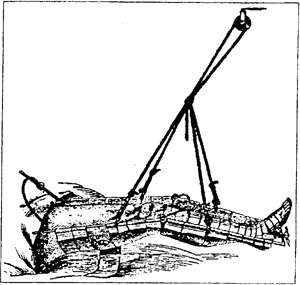History Among John Hodgen's Contributions
Lower Extremity Fracture Splints During the Civil War
Many lives and limbs were saved by the widespread use of fracture splints during the Civil War. Understandably, there was little concern about the protection of upper extremity fractures because most of these patients could sit upright in an ambulance and help adjust themselves. This was not the case, however, with lower limb fractures, particularly those of the femur. Injuries to the hip were considered the gravest of all wounds; these patients suffered terribly, not only on the battlefield but following attempts at stabilization of the bony fragments. Ever more ingenious lower extremity fracture splints were devised, and the use of instruments designed by Nathan Ryno Smith (1797-1877), Gurdon Buck (1807-1877), and John Hodgen (1826-1882) represents one of the high points of Civil War surgery.
At the beginning of the war, the army's medical department furnished Smith's anterior splint as an aid in the treatment of leg fractures. Smith had devised his suspensory splint while serving as professor of surgery at the University of Maryland Originally described in the Maryland and Virginia Medical Journal in 1860, Smith's apparatus was a clumsy affair. Although the splint was one of the most commonly used, it was not initially well received by many physicians because of poor results from incorrect application of the device. Improper use led to malunions and ulcerations, and medical journals had to include instructions regarding the proper application of the splint to prevent further iatrogenic injuries. Suspension was from the ceiling, and traction of the limb was obtained by moving the bed backward or forward from the ceiling attachment. Surgeons were told to suspend the weight farther from the body for proximal fractures of the lower extremity. For distal fractures, the suspension was more vertically positioned. Blocks placed under the foot of the bed could be used to give additional countertraction and prevent the soldier from being pulled off the bed. Gurdon Buck was a surgeon at New York Hospital when in 1862 he provided the first description of the extension apparatus with which he is eponymically linked. Buck's device worked by means of applying tape to the skin; friction between the tape and skin permitted the application of force, which was mediated through a cord over a pulley, suspending a weight. Buck described the device in the Bulletin of the New York Academy of Medicine:
Extension, maintained as it is by a weight and pulley, with an elastic band interposed, is continuous and self-sustaining; constantly antagonizing the contraction of the muscles, thereby preventing the rough extremities of the bone fragments fretting the soft parts. If applied immediately after the injury, as it may be, the spasmodic twitchings, which are so excruciating, are prevented, and the patient made comfortable from the outset.
Perhaps the greatest contribution to orthopedics during the Civil War was the Hodgen splint, first described by John Hodgen in 1863. Hodgen received his medical degree from Missouri Medical College in St Louis in 1848.
He began his academic career as a demonstrator of anatomy at his alma mater. During the Civil War, he joined the faculty of a rival institution, St. Louis Medical College, where he eventually served as dean and professor of surgical anatomy. His splint was a wire suspension device for the treatment of fractures of the middle or lower segment of the femur. Writing in the St Louis Medical and Surgical Journal, Hodgen claimed that his apparatus was a combination of the principles of Smith's anterior splint and Buck's strip bandage support. The use of the Hodgen splint was said to ensure complete extension of the limb while preventing contraction. It was able to accomplish this in such a way, Hodgen claimed, that...
the limb is entirely free from compressing bandages ... the limb may at any time be examined without disturbing the dressing ... and the freedom with which the limb moves ... allows the patient to sit up, to move to any part of the bed ... without disturbing the fracture or causing the least pain.
Hodgen's suspension cradle splint became the fore-runner of the well-known Thomas splint, made famous in World War I.